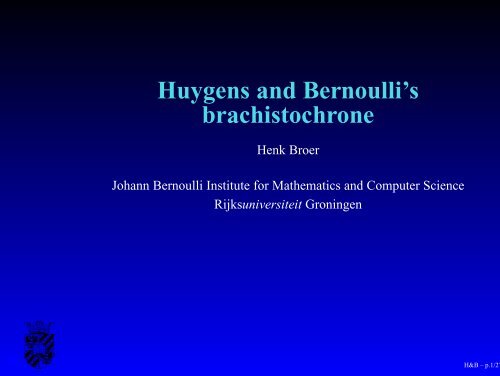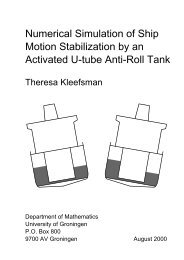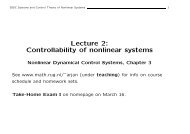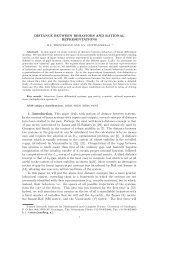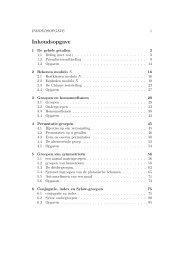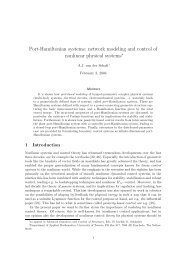Huygens and Bernoulli's brachistochrone - Rijksuniversiteit Groningen
Huygens and Bernoulli's brachistochrone - Rijksuniversiteit Groningen
Huygens and Bernoulli's brachistochrone - Rijksuniversiteit Groningen
Create successful ePaper yourself
Turn your PDF publications into a flip-book with our unique Google optimized e-Paper software.
H&B – p.1/27<strong>Huygens</strong> <strong>and</strong> Bernoulli’s<strong>brachistochrone</strong>Henk BroerJohann Bernoulli Institute for Mathematics <strong>and</strong> Computer Science<strong>Rijksuniversiteit</strong> <strong>Groningen</strong>
H&B – p.2/27Summaryi. Christiaan <strong>Huygens</strong>’s isochronous curveii. Evolute <strong>and</strong> evolventiii. Johann Bernoulli’s surpriseiv. Literaturehttp://www.math.rug.nl/˜broer
H&B – p.3/27<strong>Huygens</strong> <strong>and</strong> BernoulliChristiaan <strong>Huygens</strong> Johann Bernoulli1629–1695 1667–1748
<strong>Huygens</strong>’s isochronous curveHooke <strong>and</strong> Newton ⇒equation of motion springNotation:mx ′′ = −kxx ′ (t) = dx(t) ,x ′′ (t) = d2 x(t)dt dt 2Abbreviate ω = √ k/m, get solutionx(t) = R cos(ωt + φ)Period P = 2π/ω independent of amplitude R:isochronyH&B – p.4/27
H&B – p.6/27Commentary1. Potential energy: V (x) = 1 2 ω2 x 2 :harmonic oscillatorx ′′ = −ω 2 x = − dVdx (x)2. Pendulum x ′′ = −ω 2 sinx, ω = √ g/lan-isochronous: period −→ ∞ as x → π3. Gestalt-switch: bead moves along wire profilein vertical plane (gravitation, no friction)pendulum ←→ circleWhat profile provides harmonic oscillations(hence isochrony)?
Parametrization cycloidRoll wheel ( radius ̺) along ceiling −→ξ(ϕ) = ̺(ϕ + sin ϕ),η(ϕ) = ̺(1 − cosϕ)parameter ϕ called rolling angleH&B – p.7/27
H&B – p.8/27Arclength cycloidarclength x = x(ϕ) (using Pythagoras):dx = √ dξ 2 + dη 2 == √ (dξ/dϕ) 2 + (dη/dϕ) 2 dϕ == ̺√2 √ 1 + cos ϕ dϕ = 2̺ cos ϕ 2 dϕ x(ϕ) = 4̺ sin ϕ 2
Cycloidal wire profileVertical heightη(ϕ) = 2̺ sin 2 ϕ 2 = 18̺(x(ϕ))2 potential energy “V = mgη” : V (x) = mg8̺ x2−→ equation of motion beadx ′′ = − g 4̺x :a harmonic oscillator with ω = √ g/(4̺)Conclusion: cycloid isochronous curve(also tautochronous ...)H&B – p.9/27
H&B – p.10/27Evolute <strong>and</strong> evolventSocietal problem in 17th century:determination of longitude at sealongitude ∼ time (360 = 15 × 24)pendulum clock: period increases with amplitudeTo find adapted, isochronous pendulumIdea: ‘cheeks’ shorten length l,hence shorten period, at larger amplitudeWhat is the shape of these ‘cheeks’?(musea Boerhaave, Hofwijck, Teylers)Related problems- Period as a function amplitude (elliptic integrals)- Geometrical properties of curves <strong>and</strong> their evolute
H&B – p.13/27<strong>Huygens</strong>’s solutionK(ϕ) = chord between C(ϕ) en E(ϕ)Do you see it coming ?
The master himself . . .H&B – p.14/27
H&B – p.15/27Evolute <strong>and</strong> evolventEvolute E contains the centers of curvature of theevolvent C <strong>and</strong> hence evolves the normal-bundle of Calso think of an optical caustic ...
H&B – p.16/27Detailed formulation1. K(ϕ) is tangent to E <strong>and</strong> perpendicular to C ;2. |K(ϕ)| is radius of curvature of C in C(ϕ)Comments:- Pendulum attached to cusp of Echord evolves along ‘cheeks’ E=⇒ mass follows C- K⊥C ∼ instantaneous rotation in rolling-wheelconstruction of cycloid;NB: K⊥C ⇒ dynamics of friction-less beadH.W. Broer, <strong>Huygens</strong>’ isochrone slinger. Euclides 70(4) (1995) 110-117
Check with high school computationsLemma: K(ϕ)//E ′ (ϕ) <strong>and</strong>K(ϕ)⊥C(ϕ)Proof: On the one h<strong>and</strong>K(ϕ) = C(ϕ) − E(ϕ) =0@2 sin ϕ−2 − 2cos ϕ1A =0101@ 2 sin ϕ 2 cos ϕ 2−2 cos 2 ϕ2A ‖@ sin ϕ 2−cos ϕ 2A;On the other h<strong>and</strong>E ′ (ϕ) =0@ 1 − cos ϕ−sin ϕ1A =0@2 sin 2 ϕ2−2sin ϕ 2 cos ϕ 21A ‖0@ sin ϕ 2−cos ϕ 21Aetc., etc., etc.NB: Check that k(ϕ) = arclength along E from E(ϕ) till extremal:On the one h<strong>and</strong> k(ϕ) = 2 √ 2 √ 1 + cos ϕ = 4 cos ϕ 2 ,On the other h<strong>and</strong> the arclength equals 4 sin ϕ+π = 4sin( ϕ 2 2 + π 2 ) = 4 cos ϕ 2 ;“figures !”QEDH&B – p.17/27
H&B – p.18/27Johann Bernoulli’s surpriseThe <strong>brachistochrone</strong> problem (<strong>Groningen</strong> 1696):Given: Two points P <strong>and</strong> Q in vertical plane underinfluence of gravityRequest: Wire profile for bead to slide from P to Q inthe shortest timeOptical metaphore:bead follows light ray through optical medium withsuitably chosen speed op propagation v = v(h)
H&B – p.19/27Two principlesP1x2α jn jjα j+1n j+1j +1NhQSpeed of propagation by Conservation of Energy12 v2 (h) − gh = constant (1)Lightray by Fermat Principle of least time:
H&B – p.20/27DiscretisationHorizontal layers 1, 2,... ,N of equal width <strong>and</strong> withconstant speed of propagation v j , 1 ≤ j ≤ NLightray follows broken straight line,refraction according to Snell’s lawLimit N → ∞ give cycloid: rolling angle ϕ is doublethe inclination angle with the vertical directionThis assertion needs proof!
H&B – p.21/27Fermat implies Snell (Leibniz 1684)Willebrord Snellius Gottfried Wilhelm Leibniz1580–1626 1646–1716
H&B – p.22/27OpticsPn 1 = 1/v 1α 1RδR ′α 2n 2 = 1/v 2QRefraction between two media:n j = 1/v j ,j = 1, 2 refraction indicesSnell’s Law:n 1 sinα 1 = n 2 sinα 2
H&B – p.23/27Optics ctd.δsinα 1δsinα 2n 1 = 1/v 1Rα 1δα 2R ′n 2 = 1/v 2Proof: Take variation of an arbitrary path P → R → Q to P → R ′ → Q with R ′ − R = δTime difference:δn 1 sin α 1 − δn 2 sin α 2 + O(δ 2 )Optimal choice for R :n 1 sin α 1 = n 2 sin α 2QEDComment: A high school proof exists with rectangles . . .
H&B – p.24/27Deduction cycloidSnell’s law between successive layerssinα jv j= sinα j+1v j+1, j = 1, 2,... ,NAs N → ∞ this gives another conservation law ∗sinαv= C (2)From conservation laws (1) en (2) will obtainparametrized curveα ↦→ (x(α),h(α))∗ Think of translation symmetry in x–direction <strong>and</strong> Noether’s theorem
H&B – p.25/27A few more high school computationsLemma (abbreviating v ′ = dv/dh)v ′ = g v<strong>and</strong>cos α = Cv ′ dhdα ,Proof: Differentiate (1) with respect to h <strong>and</strong> (2) with respect to αQEDThuswhile:dxdαIntegration then givesdhdαlemma== tan αdhdα1Cgv cos α(2)= 12C 2 g(3)= v sin α (2)= 12C 2 (1 − cos2α)gsin2α (3)h(α) = h 0 − 14C 2 g cos2αx(α) = x 0 + 14C 2 (2α − sin2α) :gcycloid with rolling angle ϕ = 2α <strong>and</strong> radius ̺ = 1/(4C 2 g)QED
H&B – p.26/27Commentary1. Challenge in Acta Eruditorum (twice)Many contemporaries sent in solutionNewton’s was anonymous, however,ex ungue leonem cognavi2. Nowadays excercise in course in Calculus ofqVariations e.g., with Lagrangian L(h, h ′ 1+(h) =′ ) 2−2ghH.H. Goldstine, A History of the Calculus of Variations from the 17th through the 19th Century.Studies in the History of Mathematics <strong>and</strong> Physical Sciences 5, Springer-Verlag (1980)
H&B – p.27/27Background bibliography1. J.M. Aarts, Meetkunde: facetten van de planimetrie en stereometrie, Epsilon Uitgaven 47(2000)2. V.I. Arnold, <strong>Huygens</strong> & Barrow, Newton & Hooke. Birkhäuser (1990)3. O. Bottema, Theoretische Mechanica, Epsilon Uitgaven 3 (1985)4. H.W. Broer, <strong>Huygens</strong>, Bernoulli en enige atmosferische optica. (2011) (in preparation)5. H. Erlichson, Johann Bernoulli’s <strong>brachistochrone</strong> solution using Fermat’s principle ofleast time. Eur. J. Phys. 20 (1999) 299–3046. J.A. van Maanen, Een Complexe Grootheid, leven en werk van Johann Bernoulli,1667–1748. Epsilon Uitgaven 34 (1995)


